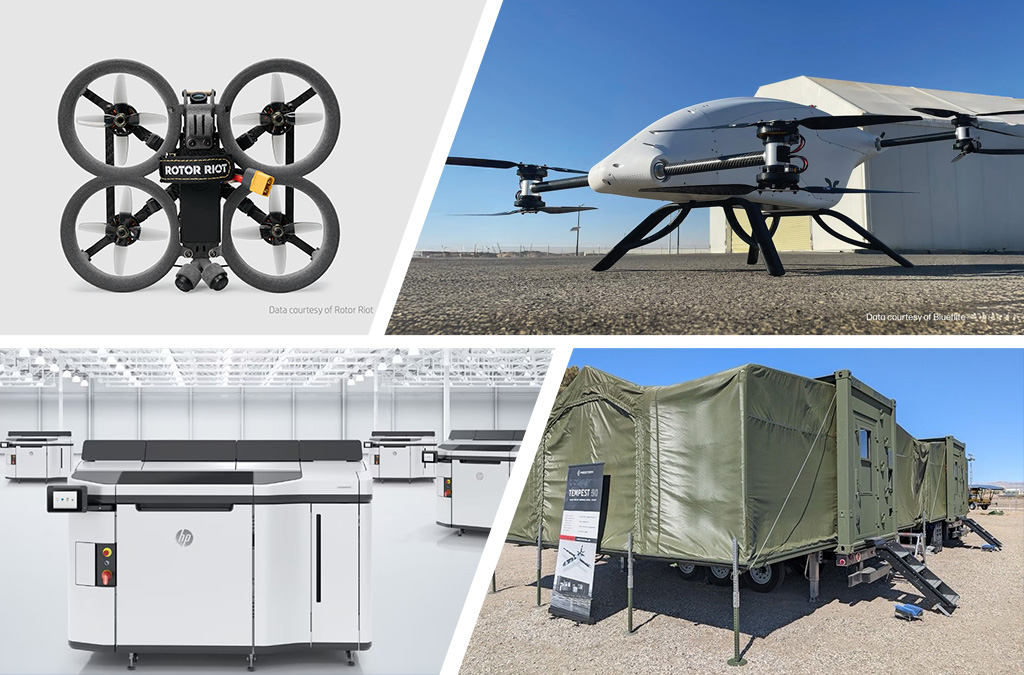Drone manufacturers are always looking for ways to produce aircraft that are made with light-weight materials to enhance efficiency. A drone that is lightweight creates more room for heavier payloads or longer flight times, both of which accelerate the usefulness of an operation. Many drone manufacturers have taken to 3D printing, otherwise known as additive manufacturing, to create lightweight yet durable parts for their drones.
Another benefit to additive manufacturing is that these companies now have the opportunity to source their own parts domestically, a practice that is becoming critical as U.S. regulations crack down on imported hardware.
To discuss this shift to stateside manufacturing with this method, Commercial UAV News hosted a webinar sponsored by HP entitled Made in America: “Redefining UAV Production with Additive Manufacturing.” This webinar featured a panel discussion with Emily Levin, 3D application engineer at HP; James McClearen, CTO at Blueflite; Drew Camden, COO at Unusual Machines; and Ian Muceus, Co-Founder, lead inventor, and CTO at Firestorm.
The webinar was moderated by Jarrid Wittkopf, 3D application engineer at HP, who led the conversation focusing on overcoming the challenges of manufacturing in the U.S. and how adopting additive manufacturing with HP’s Multi-Jet Fusion (MJF) has helped their company’s mission.
Wittkopf kicked it off by asking the group about the challenges they face as manufacturers and how additive manufacturing could be a potential fix. All agreed that the biggest hurdle of the manufacturing for the drone industry is staying on top of technological advancements. The industry evolves rapidly, but additive manufacturing allows for “just in time” production and faster adaptation to new designs.
“When you’re at the bleeding edge, it’s hard to use technology that can’t keep up with the industry,” stated Muceus. Levin responded by emphasizing that “additive manufacturing provides customization and the ability to be adaptable. We can push boundaries with 3D printing.”
The other looming challenge each company faces is the limitations of production in the U.S., as China is currently the global leader when it comes to manufacturing drones in a cheap and efficient way. Despite this, U.S. regulations are cracking down on Chinese-made drones, meaning there is a growing demand for American made drones and components.
Concerns around data security are the main driver to limit imported hardware. Panelists discussed how domestic manufacturing, with the help of additive manufacturing, can reinforce trust in the industry.
“Now we have a sense of security, and you can feel better about where your data is going. Bringing it domestic means all our companies are doing more in-house, having the confidence that you will be resilient. It feels good to have control over that aspect of the business,” explained Camden. Other panelists agreed with this sentiment, noting the value in having your customers’ trust is essential to the success of the business.
On the topic of stateside manufacturing, a sort of double-edged sword came up around labor. While boosting manufacturing in the U.S. would stimulate the economy and create more jobs, part of the reason manufacturing currently outsources to foreign countries is the high cost of labor in the states.
Muceus believes that this shouldn’t be a roadblock when, he said, “there is a renaissance happening with the amount of CNC [Computer Numerical Control] manufacturing in the U.S. right now. We need to leverage these companies; we need to buy contracts from them. The U.S. does better if we are investing in companies here.”
The conversation went on to discuss the speakers’ adoption of MJF and how this kind of manufacturing will diminish the pre-existing struggles of domestic manufacturing. Wittkopf began with simply asking everyone why their companies adopted MJF. The common draw for each was the ability to have repeatable part production that is sustainable yet made with high-quality material.
“From a customer standpoint, they can be producing these repeatable parts. It’s a more scalable production process, and they get high-quality parts out of it. The strength to weight ratio is important with drones and MJF can provide that.” said Levin.
Other panelists highlighted how MJF’s technology has reshaped their approach to product design, enabling them to nest parts within unused spaces, customize joints and components for better aerodynamics, and enhance both appearance and performance through vapor smoothing and durable nylon materials. One panelist uses MJF to create tools in addition to drone parts.
“Now you can make soft tools with MJF and I think that’s a big enabler that people should think about with this technology and not solely a focus on end pieces,” said McClearen.
The webinar wrapped up with each panelist sharing what they hope to see for the future of additive manufacturing in this space. Sentiments included an evolution of materials to improve performance of aircraft and reduce weight, while others hoped to see MJF push more boundaries for drone technology.
Registration for this webinar is still open, with registrants receiving access to free, on-demand recording as well as slides from the presentation.















Comments